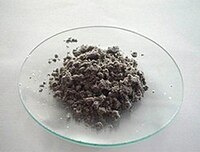
Photo from wikipedia
In this study dibenzylidene ketone derivatives (2E,5E)-2-(4-methoxybenzylidene)-5-(4-nitrobenzylidene) cyclopentanone (AK-1a) and (1E,4E)-4-(4-nitrobenzylidene)-1-(4-nitrophenyl) oct-1-en-3-one (AK-2a) were newly synthesized, inspired from curcuminoids natural origin. Novel scheme was used for synthesis of AK-1a and… Click to show full abstract
In this study dibenzylidene ketone derivatives (2E,5E)-2-(4-methoxybenzylidene)-5-(4-nitrobenzylidene) cyclopentanone (AK-1a) and (1E,4E)-4-(4-nitrobenzylidene)-1-(4-nitrophenyl) oct-1-en-3-one (AK-2a) were newly synthesized, inspired from curcuminoids natural origin. Novel scheme was used for synthesis of AK-1a and AK-2a. The synthesized compounds were characterized by spectroscopic techniques. AK-1a and AK-2a showed high computational affinities (E-value > − 9.0 kcal/mol) against cyclooxygenase-1, cyclooxygenase-2, proteinase-activated receptor 1 and vitamin K epoxide reductase. AK-1a and AK-2a showed moderate docking affinities (E-value > − 8.0 kcal/mol) against mu receptor, kappa receptor, delta receptor, human capsaicin receptor, glycoprotein IIb/IIIa, prostacyclin receptor I2, antithrombin-III, factor-II and factor-X. AK-1a and AK-2a showed lower affinities (E-value > − 7.0 kcal/mol) against purinoceptor-3, glycoprotein-VI and purinergic receptor P2Y12. In analgesic activity, AK-1a and AK-2a decreased numbers of acetic acid-induced writhes (P < 0.001 vs. saline group) in mice. AK-1a and AK-2a significantly prolonged the latency time of mice (P < 0.05, P < 0.01 and P < 0.001 vs. saline group) in hotplate assay. AK-1a and AK-2a inhibited arachidonic acid and adenosine diphosphate induced platelet aggregation with IC50 values of 65.2, 37.7, 750.4 and 422 µM respectively. At 30, 100, 300 and 1000 µM concentrations, AK-1a and AK-2a increased plasma recalcification time (P < 0.001 and P < 0.001 vs. saline group) respectively. At 100, 300 and 1000 µg/kg doses, AK-1a and AK-2a effectively prolonged bleeding time (P < 0.001 and P < 0.01 vs. saline group) respectively. Thus in-silico, in-vitro and in-vivo investigation of AK-1a and AK-2a reports their analgesic, antiplatelet and anticoagulant actions.
Journal Title: Chemistry Central Journal
Year Published: 2018
Link to full text (if available)
Share on Social Media: Sign Up to like & get
recommendations!